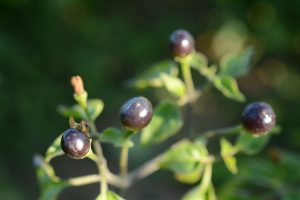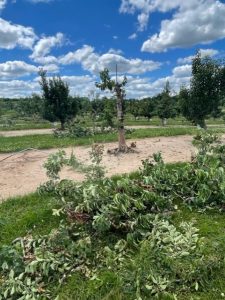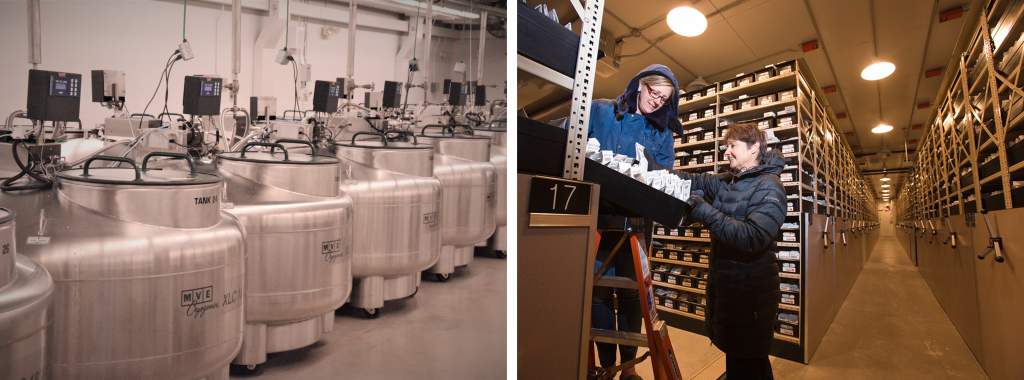Climate change impacts management of genebanks and botanic gardens
Gayle M. Volk, USDA-ARS National Laboratory for Genetic Resources Preservation, 1111 S. Mason St., Fort Collins, Colorado USA 80521 (Gayle.Volk@usda.gov)
Tara L. Moreau, University of British Columbia Botanical Garden, 804 SW Marine Drive, Vancouver, BC Canada V6T 1Z4 (Tara.Moreau@ubc.ca)
Learning Objectives
- Describe how genebanks and botanic gardens are conserving plant genetic resources threatened by climate change.
- Understand the ways climate change could affect ex situ plant collections and how management choices can be used to protect them.
outline
- Introduction
- Genebank and botanic garden responses to climate change threats
- The effects of climate change on plant genetic resource collection management
- Conclusions
- References
- Acknowledgments
1. introduction
Ex situ collections provide access to diverse plant genetic resources critical for developing plant-based solutions to climate change. Given the valuable service these collections provide (see chapter 3), it is more important than ever that genebank and botanical garden collection managers recognize climate change threats and respond accordingly.
The threat of climate change puts pressure on genebanks, seedbanks, and botanical gardens to collect those plants most vulnerable to loss and those most valuable for their potential resistance to pests and diseases and resilience to environmental conditions (Jarvis et al., 2008). Originally, collections focused on capturing the diversity of cultivars. Increasingly, collections are being expanded to include more wild species that might not have desirable cultivation properties but do have the potential of genetic diversity that can be used in breeding programs to overcome abiotic and biotic stressors (Castañeda-Álvarez et al., 2016).
Ex situ collection maintenance will also be impacted by climate change. New insect and disease pressures could affect collection health. Changing temperatures might affect dormancy, bloom, seed set, and harvest. It will become increasingly important for collections managers to adapt to these changes and to ensure that collections securely backed-up at secondary locations.
2. genebank and botanic garden responses to climate change threats
Genebanks, seedbanks, and botanic gardens conserve crop wild relatives and landraces. These plant genetic resources are becoming increasingly important as breeders seek novel plant traits and germplasm to adapt crops to a changing climate. Crop wild relatives could provide the necessary alleles that breeding programs need to develop crops that are more resilient to biotic and abiotic stresses (Dempewolf et al., 2014). Landraces provide access to cultivars that might already possess some desired traits and could grow in locations experiencing new weather patterns, temperature extremes, and pathogens/pests.
Crop Wild Relatives: Wild plants that are related to crops, either in the same or different species, that don’t usually have desired domesticated traits but do have the potential to provide useful traits/genes/alleles for crop improvement.
Landraces: Older crop varieties that have been selected and grown by farmers for generations.
Wild populations of plants have a certain level of resilience and can adapt to many changing conditions (Sgrò et al., 2010). This is due to a range of genetic diversity within populations, which must be considered when collecting for ex situ conservation efforts; sufficient variation must be captured in order to obtain some plants that are reasonably adapted (Sgrò et al., 2010). This resilience is dependent on maintaining population sizes and protecting environments and connectivity among environmental gradients (Sgrò et al., 2010).
Even without climate change considerations, the survival of crop wild relatives is already threatened. Globally, two in five plant species face extinction (Antonelli et al., 2020). Plant populations conserved in federal and state parks, forests, refugia, public lands, by environmental organizations, and in other protected areas could have some level of security, but many native plants grow on lands that are threatened by population growth, agricultural uses, and resource extraction activities (Gill et al., 2014).

Crop wild relatives growing in their native habitats may be particularly vulnerable to the effects of climate change (Aguirre-Gutiérrez et al., 2017). Those growing in already borderline locations or with limited range might not have the fecundity or ability to migrate to more suitable regions. Some climate effects such as extreme temperatures, drought, flooding, or forest fires could cause widespread losses and could quickly eradicate plant populations. However, in some cases, plant populations might be better suited to new conditions such as warmer temperatures and increased rainfall. Although climate change models provide some guidance with respect to what might occur, very little is known about the specific responses that will be experienced by plant populations and corresponding changes in pests and pathogens. Ecological niche modelling efforts are underway, but often necessary baseline information is lacking (Sthapit et al., 2012). Published results reveal that there is an urgent need to conserve crop wild relatives before they are permanently lost (Jarvis et al., 2008; van Treuren et al., 2020).
Landrace cultivars could also be lost in response to a changing climate. Farming families that planted and nurtured old varieties might leave their farms and migrate to less hospitable locations. In addition, specific varieties may no longer thrive under the new planting conditions and are not likely to be grown by others in different locations due to less economically competitive traits.
Crop wild relatives and landraces can be protected in genebanks and public gardens, although it is not easy to identify, collect, and safeguard these plant materials in ex situ collections (Dempewolf et al., 2014). The complementary nature of conserving plants in the wild and in genebank and public garden settings significantly increases their security and availability. Collaborative efforts are underway to document, strategically collect, and maintain these critical plant genetic resources before they are lost (Ramirez-Villegas et al., 2022; Khoury et al., 2019; 2020).
3. the effects of climate change on plant genetic resource collection management
Safe, secure, and enduring ex situ plant collections are necessary for the future of agriculture. These collections are often regenerated or grown as perennials in field conditions. Climate change will affect the management strategies, including those relating to pollination activities and pest/pathogen management, for many crops and their corresponding germplasm collections, requiring that plans are made prior to the loss of any critical plant genetic resources.
3.1. Climate change threats to genebanks and botanic gardens
Ex situ plant collections will be affected by a changing climate (Volk et al., 2023). Low water availability as well as flooding events could affect field plantings. Hot summer temperatures might affect bloom, pollinators, pollen viability, and seedset, while warm winters might affect the acquisition of dormancy and sufficient chilling hours for subsequent budbreak and bloom in perennial crops. New diseases and pests are a particular threat because they could spread to regions in which they could not previously be supported. In addition, pathogen die-off during cold winters may not occur if winters are warmer than they have been in the past. Plant genebank collections are at risk because both resistant and susceptible varieties could be present, and susceptible plants might harbor pathogens and increase the probability of multi-year outbreaks.

3.2. Plant collection management considerations
Regeneration
Genebanks and public gardens often have a commitment to maintain plant collections indefinitely. For seed collections in genebanks or community seedbanks, this means periodically regenerating seeds in field or greenhouse conditions to replenish inventories that are in long-term refrigerator or freezer storage. Successful regeneration resulting in quality seeds is dependent on plants being grown in conditions that promote flowering, pollination, and seed-set (Volk et al., 2023). Current grow-out sites might not provide the necessary conditions and new grow-out locations might be needed. For example, the Western Regional Plant Introduction Station in Pullman, Washington, USA experienced a heat dome with 105 °F (40.6 °C) temperature on June 29, 2021. Lentils that were being regenerated in the field during that heat event failed to set seeds (C. Coyne, personal communication). High quality seed production is imperative for genebanks. It improves longevity and reduces the need for risky grow-out procedures.
Perennial plant collections
Plant collections maintained perennially as trees, vines, shrubs, herbaceous plants, or other forms could be particularly vulnerable to a changing climate (Volk et al., 2023). These perennial field or indoor plants are susceptible to pests and diseases, drought/flooding, and disasters such as fires, hurricanes, and tornadoes. The diversity maintained in ex situ collections increases their susceptibility because some individuals might be particularly susceptible to some biotic stressors (pests, pathogens, and diseases), which could then spread to other individuals. It might be necessary to develop new management practices to respond to new pests and diseases. In addition, field plantings might require irrigation, which requires access to water sources. In some cases, changing winter conditions could cause flowering to occur early in the season and risk the loss of fruit set due to late-season frosts (Volk et al., 2023).
Some perennial plant collections, or portions thereof, may need to be relocated to different growth sites. When there are duplicate (genetically identical) plants maintained at the same location, both are susceptible to the same threats. When possible, duplicated collections can be established at multiple locations, or under different growing conditions such as field and greenhouse. Additional facilities such as greenhouses might be needed, particularly for collection duplication or to keep plants safe from pests, diseases, and adverse environmental conditions (Sthapit et al., 2012). Greenhouses might need modifications and updates to provide cooling, insect-proof screens, and high quality temperature control for optimal plant growth (Volk et al., 2023).
Secondary backups
Collection security is paramount because the efforts of previous generations of collectors and curators could be lost in a single season due to abiotic or biotic threats (FAO, 2014). Many seed types can be safely and economically secured at multiple locations using optimized cold temperature storage conditions that predict high survival levels for decades to centuries. In contrast, duplicate field collections are usually prohibitively expensive due to land, labor, and maintenance costs. Some specific collections or parts of collections could be duplicated, but widescale field duplication efforts are rare.
In vitro (tissue culture) collections maintained in laboratory settings, as well as cryopreserved materials have been used to conserve some crops that are not generally propagated as seeds. Seeds that do not respond well to refrigerator or freezer conditions can also be cryopreserved. Cryopreservation efforts are labor intensive to prepare and process materials for liquid nitrogen storage, but once successfully placed in liquid nitrogen and confirmed to be alive through viability assays, these collections are often expected to survive for decades (Lynch et al., 2007).

Prioritizing conservation targets
In addition to an increased emphasis on conserving landraces and crop wild relatives in larger genebanks, it is imperative that adequate support be provided to smaller institutions with more of a local scope. It is critical to ensure community seedbank collections have access to secure long-term backup storage (Hodgkin and Bordoni, 2012). These collections may have locally adapted crops and varieties that are not available elsewhere.
Many institutions focus on ecologically valuable plants rather than agriculturally valuable ones. Botanical gardens have placed an emphasis on conserving exceptional species, those that are threatened or endangered, which may not be crop plants or their wild relatives (Westwood et al., 2020). This includes cryopreservation activities for long-term secure backups (Westwood et al., 2020).
Evaluations
There is an increased need for collection evaluations using replicated plots for resistance to biotic and abiotic stresses, as well as performance assessments under a wide range of environmental conditions (Hodgkin and Bordoni, 2012; Sthapit et al., 2012). Many trait evaluations are needed, including flowering time, root physiology, water use efficiency, etc. (Jarvis et al., 2008). The data from evaluations can be made available through public information systems.
Outreach and communication
It is increasingly important to have outreach, education, and communication networks to share information. This information ranges from crop and varietal responses to the environment, production methods (particularly for new pests and diseases), and where to acquire plant materials (Vernooy et al., 2017). This also requires sharing knowledge and expertise for seed collection, storage, multiplication, and distribution from the wild to ensure genetic diversity is not lost. Long-distance exchange networks might need to be promoted among farmers, particularly after environmental disasters (Jarvis et al., 2008). Climate change will likely require increased access to plant genetic resources in genebanks, community seedbanks, and public gardens, as well as an increased interdependence between plant collections and user communities (Primack and Miller-Rushing, 2009; Primack et al 2021).
4. Conclusions
Genebanks, seedbanks, and botanical gardens have an essential role in mitigating and adapting to the effects of climate change. While these collections are also susceptible to environmental changes, informed management decisions can be used to protect them. These may involve developing new pest and disease management practices, modifying irrigation, backing up collections at secondary locations and under different storage conditions, prioritizing new conservation targets, and improving communications around methods, data, and material availability. With a greater focus on conserving landraces, crop wild relatives, and exceptional species, these collections of plant genetic resources are increasingly poised to prevent the complete loss of valuable genetic material and are better equipped to support the researchers, breeders, and growers that are working to defend food security in the face of a rapidly changing climate.
5. references
Aguirre-Gutiérrez J, van Treuren R, Hoekstra R, van Hintum TJL. 2017. Crop wild relatives range shifts and conservation in Europe under climate change. Diversity and Distributions 23:739-750. DOI: 10.1111/ddi.12573
Antonelli A, Smith RJ, Fry C, Simmonds MSJ, Kersey PJ, et al. 2020. State of the World’s Plants and Fungi. Royal Botanic Gardens, Kew. DOI: 10.34885/172
Castañeda-Álvarez N, Khoury CK, Achicanoy HA, Bernau V, Dempewolf H, Eastwood RJ, et al. 2016. Global conservation priorities for crop wild relatives. Nature Plants 2:16022. DOI: 10.1038/nplants.2016.22
Dempewolf H, Eastwood RJ, Guarino L, Khoury CK, Müller JV, Toll J. 2014. Adapting Agriculture to Climate Change: A Global Initiative to Collect, Conserve, and Use Crop Wild Relatives. Agroecology and Sustainable Food Systems 38:369-377. DOI: 10.1080/21683565.2013.870629
FAO. 2014. Genebank Standards for Plant Genetic Resources for Food and Agriculture. Revision edition. Rome. Download from: fao.org/3/i3704e/i3704e.pdf
Gill BS, Raupp WJ, Friebe B. 2014. Dual threats of imperiled native agroecosystems and climate change to world food security: Genomic perspectives. Journal of Crop Improvement 28:88-98. DOI: 10.1080/15427528.2014.865411
Hodgkin T, Bordoni P. 2012. Climate change and the conservation of plant genetic resources. Journal of Crop Improvement 25:329-345. DOI: 10.1080/15427528.2011.609928
Jarvis A, Lane A, Hijmans RJ. 2008. The effect of climate change on crop wild relatives. Agriculture, Ecosystems and Environment 126:13-23. DOI: 10.1016/j.agee.2008.01.013
Khoury CK, Greene SL, Krishnan S, Miller AJ, Moreau T. 2019. A road map for conservation, use, and public engagement around North America’s crop wild relatives and wild utilized plants. Crop Science 59:2302-2307. DOI: 10.2135/cropsci2019.05.0309
Khoury CK, Carver D, Greene SL, Williams KA, Achicanoy HA, Schori M, Leon B, Wiersema JH, Frances A. 2020. Crop wild relatives of the United States require urgent conservation action. Proceedings of the National Academy of Sciences 117:33351-33357. DOI: 10.1073/pnas.2007029117
Lynch PT, Benson EE, Harding K. 2007. Climate change: the role of ex situ and cryo-conservation in the future security of economically important, vegetatively propagated plants. The Journal of Horticultural Science and Biotechnology 82:157-160. DOI: 10.1080/14620316.2007.11512213
Primack RB, Ellwood ER, Gallinat AS, Miller-Rushing AJ. 2021. The growing and vital role of botanical gardens in climate change research. New Phytologist 231:917-932. DOI: 10.1111/nph.17410
Primack RB, Miller-Rushing AJ. 2009. The role of botanical gardens in climate change research. New Phytologist 182:303-313. DOI: 10.1111/j.1469-8137.2009.02800.x
Ramirez-Villegas J, Khoury CK, Achicanoy HA, et al. 2022. State of ex situ conservation of landrace groups of 25 major crops. Nature Plants 8:491-499. DOI: 10.1038/s41477-022-01144-8
Sgrò CM, Lowe AJ, Hoffmann AA. 2010. Building evolutionary resilience for conserving biodiversity under climate change. Evolutionary Applications 4:326-337. DOI: 10.1111/j.1752-4571.2010.00157.x
Sthapit BR, Ramanatha Rao V, Sthapit SR. 2012. Tropical Fruit Tree Species and Climate Change. Bioversity International, New Delhi, India. Available from: bioversityinternational.org/e-library/publications/detail/tropical-fruit-tree-diversity/
van Treuren R, Hoekstra R, Wehrens R, van Hintum T. 2020. Effects of climate change on the distribution of crop wild relatives in the Netherlands in relation to conservation status and ecotope variation. Global Ecology and Conservation 23:e01054. DOI: 10.1016/j.gecco.2020.e01054
Vernooy R, Sthapit B, Otieno G, Shrestha P, Gupta A. 2017. The roles of community seed banks in climate change adaption. Development in Practice 27:316-327. DOI: 10.1080/09614524.2017.1294653
Volk GM, Carver D, Irish BM, Marek L, Frances A, Greene S, Khoury CK, Bamberg J, del Rio A, Warburton ML, Bretting PK. 2023. Safeguarding plant genetic resources in the United States during global climate change. Crop Science 1-23. https://doi.org/10.1002/csc2.21003
Westwood M, Cavnder N, Meyer A, Smith P. 2020. Botanic garden solutions to the plant extinction crisis. Plants, People, Planet 3:22-32. DOI: 10.1002/ppp3.10134
6. acknowledgments
Citation: Volk GM, Moreau TL. 2023. Climate change impacts management of genebanks and botanic gardens. In: Volk GM, Moreau TL, Byrne PF. Conserving and Using Climate-Ready Plant Collections. Fort Collins, Colorado: Colorado State University. Date accessed. Available from: https://colostate.pressbooks.pub/climatereadyplantcollections/chapter/genebanks-and-botanic-gardens/
This eBook chapter was developed through a collaboration among USDA-Agricultural Research Service, Colorado State University, and the University of British Columbia Botanic Garden, with additional funding from the USDA-NIFA-Higher Education Challenge Grant (2020-70003-303930).
Editor: Katheryn Chen
conservation of plant genetic resources outside their natural habitat
the organs and tissues (seeds, fruits, cuttings, pollen, tissue cultures, etc.) by which plants can be propagated (synonymous with plant germplasm)
a crop variety produced by scientific breeding or farmer selection methods
the wild undomesticated plants most closely related to agricultural crops that potentially possess useful traits/genes/alleles for crop improvement
a local plant variety, usually genetically heterogeneous, with distinctive characteristics arising from selection over time for adaptation to localized conditions or food preferences
the organs and tissues (seeds, fruits, cuttings, pollen, tissue cultures, etc.) by which plants can be propagated (synonymous with plant genetic resources)
plant species that are threatened or endangered
in a climate change context, actions that reduce or prevent greenhouse gas emissions or that lower the amount of greenhouse gases in the atmosphere
in a climate change context, taking action to prepare for and adjust to both the current and projected impacts of climate change

